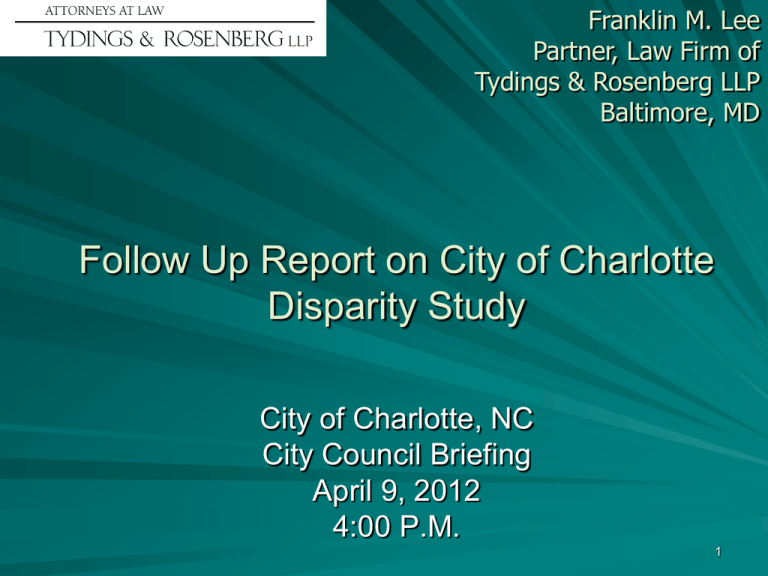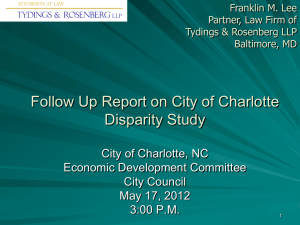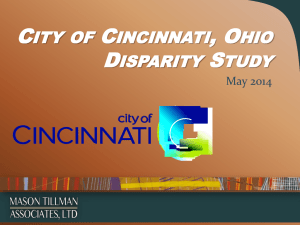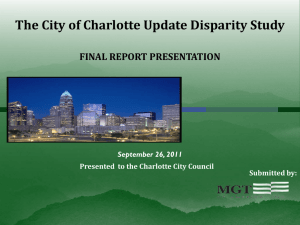Follow Up Report on City of Charlotte Disparity Study City Council Briefing
advertisement

Franklin M. Lee Partner, Law Firm of Tydings & Rosenberg LLP Baltimore, MD Follow Up Report on City of Charlotte Disparity Study City of Charlotte, NC City Council Briefing April 9, 2012 4:00 P.M. 1 Background In October 2010 the City retained MGT of America, Inc. (MGT), to conduct a Disparity Study comparing use and availability of minority and women owned business enterprises (MWBEs) on City contracts. The 2010 Disparity Study covered City spending from July 1, 2005 through June 30, 2010, updating the City’s 2003 Disparity Study (also conducted by MGT). 2 MGT presented findings and recommendations to City Council in September, 2011. MGT concluded that while some evidence may support the restoration of race and gender conscious subcontracting goals for certain minority groups, the study’s cumulative evidence did not support a legally defensible race and gender conscious contracting program. On February 13, 2012, following review of the Disparity Study by the Economic Development Committee and the Disparity Study Advisory Committee, City Council voted to retain Tydings & Rosenberg LLP to review MGT’s findings and recommendations. 3 CORE ISSUE Considering the totality of the evidence presented, does the City of Charlotte have a strong basis in evidence for considering the use of narrowly tailored race / genderconscious remedial policies to more fully remedy the ongoing effects of marketplace discrimination upon its contracting? 4 CORE ISSUE ANSWER: YES Particularly in the context of the inability of an aggressive small business enterprise program over an 8-year period to fully eliminate significant disparities in the utilization of ready, willing, and able M/WBE firms. 5 MGT Conclusion Differs – No “strong basis in evidence” for following reasons: 1.Existing statistically significant disparities in part due to larger M/WBE availability in recent years. 2.Increased utilization of M/WBE subcontractors in absolute dollars and percentage participation since SBO Program was adopted in 2003. 6 MGT Conclusion Differs – No “strong basis in evidence” for following reasons: 3.Percentage of total contract dollars going to M/WBE construction subcontractors tripled since 2003. 4.Increased utilization of M/WBE subcontractors in absolute dollars and percentage participation since SBO Program was adopted in 2003. 7 MGT Conclusion Differs – No “strong basis in evidence” for following reasons: 5.The SBO Program has been a more effective remedy than Charlotte’s former M/WBE Program 6.The Charlotte SBO Program is apparently as effective as other M/WBE programs in Charlotte area 8 MGT Conclusion Differs – No “strong basis in evidence” for following reasons: 7.Anecdotal evidence is weak. 9 Alternative View of Same Evidence 1. MGT admits that ALL of its measures of availability reflect larger M/WBE availability for this study period. “Custom Census” approach used in Study Update has been upheld repeatedly in most recent court cases “Custom Census” methodology more accurately reflects full universe of available firms MGT is right to rely upon it in latest study 10 Alternative View of Same Evidence 2. Utilization numerators in disparity ratios from two different time frames are not interchangeable: For Example: Assume a 1/2 disparity ratio in 2003 as compared to 5/10 disparity ratio in 2010 Misleading to conclude that SBO Program is successful simply because utilization numerator is five times as big in 2010… disparity ratios remain the same. 11 Alternative View of Same Evidence 3. Undisputed evidence reflects that SBO Program did not fully eliminate disparities: Size of disparities in 2003 have been reduced somewhat But substantial and statistically significant disparities remain 4. After 8 years of race-neutral SBO Program policy, it is time to consider the use of more aggressive race- conscious remedial policies on a narrowly tailored basis. 12 Alternative View of Same Evidence 5. Presumed superiority of SBO Program as compared to past City M/WBE Program and current nearby M/WBE programs is not necessarily valid, as all M/WBE Programs are not created equal. MGT has not demonstrated that those M/WBE Programs are in keeping with today’s “best practices” such as: Effective and narrowly-tailored outreach Strong monitoring Contract-specific goal-setting Enforcement through sanctions Adequate staff and resources Automated bidder registration, and automation in tracking of availability and actual payment data 13 Alternative View of Same Evidence 6. Because marketplace discrimination often occurs outside the presence of those affected, there is low probability for victims to have direct knowledge: Yet, anecdotal evidence is quite robust (over 100 particularized accounts / affirmations of discrimination, w/ four different methodologies) Anecdotal evidence bolsters conclusion that discrimination occurs in many forms Discrimination likely occurs in much more than a few isolated instances. 7. Combined with widespread statistical disparities, anecdotal evidence supports class-based remedies. 14 POLICY RECOMMENDATIONS Hybrid SBO / M/WBE Program with following features: Contract-specific determinations for the application of SBO or M/WBE program features based on clear criteria SBE or M/WBE subcontracting goals with good faith efforts Vendor rotation on informal contracts Increase formal bid threshold to $500,000 on construction contracts 15 POLICY RECOMMENDATIONS Automated Mandatory Centralized Bidder Registration: – Enhances targeted automated outreach – Greatly reduces administrative burden for: satisfying good faith efforts requirements contract-specific goal setting tracking and reporting of M/WBE utilization thru payments providing transparency in payments for better enforcement of prompt payment provisions 16 QUESTIONS??? Franklin M. Lee, Esq. Partner Tydings & Rosenberg LLP 100 E. Pratt Street, 26th Fl. Baltimore, MD 21202 (410) 752-9734 E-mail: flee@tydingslaw.com 17




